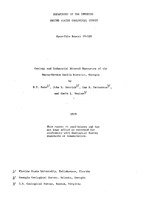The Macon-Gordon kaolin district is about 80 miles (130 km) southeast of Atlanta, Georgia. It extends across the boundary between, and includes parts of, the Piedmont and Atlantic Coastal Plain physiographic provinces. The rocks in the Piedmont are mainly intensely folded sericite schist and granite gneiss containing irregular masses of amphibolite and feldspathic biotite gneiss and scattered igneous intrusive rocks. Most of the crystalline rocks are thought to be of Paleozoic age, but some of the intrusive rocks may be younger. The crystalline rocks are cut by a major unconformity and are overlain by sedimentary formations ranging in age from Cretaceous to Miocene. The valuable kaolin deposits occur in the Cretaceous beds, undivided, and in the Huber Formation which is of Paleocene to middle Eocene age. The resources of kaolin in the district are estimated in millions of metric tons as follows: reserves, 100; subeconomic resources, 700 to 900; undiscovered resources, probably 700 to 1,000.
In addition to kaolin, the leading mineral commodity mined in the district, crushed stone and sand are now being produced, and fuller's earth and a minor amount of limestone were formerly produced. The crushed stone is quarried from igneous rocks in the Piedmont province. The sand is washed from the Cretaceous beds, undivided. The fuller's earth was mined from the Twiggs Clay Member of the Barnwell Formation, and limestone was dug from the Tivola Limestone.


